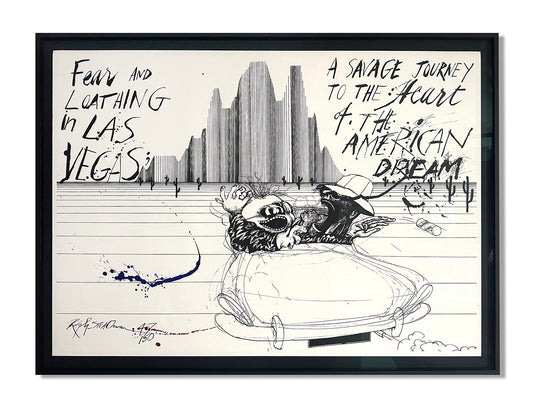Collection: Ralph Steadman
Ralph Steadman is a British artist and illustrator whose distinctive, often frenetic style has made him one of the most influential visual artists of the 20th and 21st centuries. Born in 1936 in Wallasey, England, Steadman’s work spans a wide variety of genres, including political satire, social commentary, and literary illustration. His art is characterized by chaotic, energetic lines, splattered ink, and exaggerated, almost grotesque depictions of people and places. Steadman’s ability to capture both the absurdity and the underlying darkness of the human condition has made his work both unsettling and compelling.
Steadman’s breakthrough came with his long-standing collaboration with American journalist and writer Hunter S. Thompson. The two first teamed up in 1970 when Steadman was commissioned to illustrate Thompson’s Hell’s Angels: The Strange and Terrible Saga of the Outlaw Motorcycle Gangs. However, it was their next project, Fear and Loathing in Las Vegas (1971), that truly solidified Steadman’s place in the art world.
Fear and Loathing in Las Vegas is a wild, semi-autobiographical account of Thompson’s road trip to Las Vegas, filled with drug-induced hallucinations, encounters with bizarre characters, and a scathing critique of American society. Steadman’s illustrations for the book perfectly complement Thompson’s gonzo journalism style, which blends fact, fiction, and personal narrative into a surreal, often absurd tapestry. Steadman’s signature chaotic and visceral illustrations capture the madness of the narrative, with grotesque depictions of the characters, distorted landscapes, and explosive, dripping ink lines that mirror the hallucinatory nature of the story. His images are not just illustrations, but visceral expressions of the disorientation and excesses of the 1960s counterculture.
One of Steadman’s most iconic images from Fear and Loathing is his illustration of Thompson’s alter ego, Dr. Gonzo, a menacing, disheveled figure with wild eyes and a savage demeanor. Another famous image is the chaotic depiction of Las Vegas itself—a distorted, nightmarish vision of a city consumed by excess and decadence. These images have become inseparable from the book, influencing how readers and critics alike view both the story and the era it represents.
Beyond Fear and Loathing, Steadman has worked on a wide range of projects, including illustrations for The Daily Telegraph, The New York Times, and The Guardian. His political cartoons, often mocking authority and questioning social norms, have earned him a reputation as a fierce critic of the status quo. He has also illustrated a number of classic literary works, including Alice’s Adventures in Wonderland, The Hunting of the Snark, and Animal Farm.
Steadman’s art is often described as anarchic, visceral, and full of dark humor. His use of ink—sometimes splattered, sometimes delicately controlled—gives his work a raw, primal energy. He has said that his style emerged from a desire to escape the “stiff and controlled” conventions of traditional illustration and to embrace a more intuitive, instinctive approach to drawing.
Today, Steadman is widely regarded as one of the most original and influential artists of his generation. His work continues to challenge viewers, provoke thought, and inspire new generations of artists. Whether illustrating books, critiquing politics, or capturing the absurdities of modern life, Ralph Steadman’s art remains an indelible part of the cultural landscape, with Fear and Loathing in Las Vegas standing as one of his most enduring and significant contributions.

-
Fear & Loathing in Las Vegas
Vendor:Ralph SteadmanRegular price £4,575.00 GBPRegular priceUnit price / per
Artists A-Z
-

Adrian Boswell
Adrian is a well known East London collage artist who mixes the...
-

Andrew J Millar
Andrew J Millar, born in 1983 is a British artist whose main...
-

Anna Matykiewicz
Anna Matykiewicz is a polish artist who has been living and working...
-

Benjamin Thomas Taylor
Benjamin Thomas Taylor is known for his bright, Pop Art inspired...
-

Carrie Jean Goldsmith
Carrie Jean Goldsmith uses various media to create abstract works with colour,...
-

Charming Baker
After graduating at Central Saint Martin's College in London, Charming Baker...
-

Chuck Elliott
Chuck Elliott (b. 1967, London) is a pioneer of digitally generated art....
-

Dario Santos
Dario is an independent Portugese artist based in Swindon. He moved to...
-

Dave Buonaguidi
the Real Hackney Dave Screenprint aficionado and collector of curiosities to print on.
-

David Hardy
Originally from Nottingham, London artist David Hardy's style mashes up the cult...
-

David Shrigley
David Shrigley, born in 1968 in Macclesfield, England, is a renowned contemporary...
-

Donk London
Knights of the crusade and B.boys break dancing. Rag & bone men,...

















